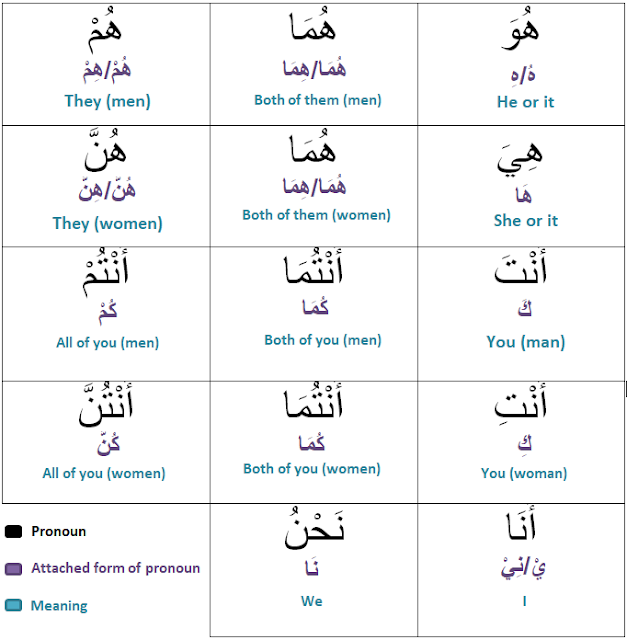Number detailed (part 2) English + Dhivehi
Number detailed (part 2)
So today we
will be looking at the remaining groups from the 6 plurals. Till now we looked
at masculine plural, human feminine plural and non-human feminine. To
understand the next two types of plurals, we need to understand the concept of
‘broken plurals’.
What is a
broken plural?
Think of the
normal way we make a word plural in English. The normal way of doing it is by
adding an ‘s’. For example car becomes cars. Toy becomes toys. Tree becomes
trees and so on.
But then
there are other words in English that change completely when we make them
plural. Like mouse becomes mice. Tooth becomes teeth. Goose becomes geese and
so on.
Similarly
there is a normal way in which we make a word plural in Arabic. And that is by
adding OONA or EENA sound at the end of a masculine word, or by adding AATUN or
AATIN sound to the end of a feminine word. Take a look at the examples below.
مُسْلِمٌ------------------ مُسْلِمُوْنَ
مُسْلِمَةٌ ---------
مُسْلِمَاتٌ
But that
there are some words in Arabic that change completely when they are made
plural. Hence they are called ‘broken plurals’. Some examples are given below.
مَسْجِد --------------- مَسَاجِد
(mosques) (mosque)
كِتَابٌ ----------------- كُتُبٌ
(books) (book)
كَافِرٌ ---------------- كُفَّارٌ
(disbelievers)
(disbeliever)
Now that we
understand the concept of broken plurals, let’s move on to the fourth kind of
plural.
Main point
to remember about broken plurals is that they won’t end with these sounds:
OONA, EENA, AATUN, AATIN
4. Human
broken plural
These are
broken plurals that talk about humans. Example:
كَافِرٌ ---------------- كُفَّارٌ
(disbelievers)
(disbeliever)
نَبِي -------------------- أَنْبِيَاء
(Prophets) (Prophet)
رَسُوْل -------------------
رُسُل
(Messengers) (Messenger)
These
plurals may also be treated like a she. But it isn’t necessary. So its correct
to say ‘they are kuffaar’ and its also correct to say ‘she is kuffaar’.
5. Non-human
broken plural
These broken
plurals talk about non-human objects. Example:
مَسْجِد --------------- مَسَاجِد
(mosques) (mosque)
كِتَابٌ ----------------- كُتُبٌ
(books) (book)
These
plurals are ALWAYS treated like a she. So Arabs say she is masjids and she is
books and so on.
6. Ism Jam’u
These are
words that are plural because the Arabs said so. They are singular the way they
sound yet they are treated like plural. We will learn only 3 words that fall
into this category as those are the words that appear in the Quran
قَوْمٌ نَاسٌ قَرْنٌ
(A
nation)
(People) (Generation)
The Arabs won’t say it is a nation or it is a
generation. They will say, ‘they are a nation’ and ‘they are a generation.’
Exercise:
Identify which kind of plural the following
words are. Label each one with one of the following: Masculine plural, Human
feminine plural, Non-human feminine plural, Human broken plural, Non-human
broken plural, Ism jam’u
ظُلُمَاتٍ (darknesses)
النَّاس (people)
صُمٌّ (deaf people)
بُكْمٌ (dumb people)
عُمْيٌ (blind people)
قَرْنٍ (generation)
أَصَابِعْ (fingers)
شُهَدَاء (witnesses)
الْحِجَارَةُ (rocks)
********************************************************************
ޢަދަދު ތަފްޞީލުކުރެވިފައި (ދެވަނަ ބައި)
މިއަދު އަޅުގަނޑުމެން ބަލާލާނީ
6 ޖަމްޢުތަކުގެ ތެރެއިން އަޅުގަނޑުމެންނަށް ބަލާނުލެވޭ 3 ޖަމްޢުއަށެވެ. މިހާތަނަށް
އަހަރުމެން ދަސްކޮށްފައި ހުރި ޖަމްޢުތަކަކީ: ފިރިހެން ޖަމްޢު، އިންސާނުންނަށް
ބޭނުންކުރެވޭ އަންހެން ޖަމްޢު، އެއްޗެއްސަށް ބޭނުންކުރެވޭ އަންހެން ޖަމްޢު މިއެވެ.
ކުރިއަށް ހުރި ދެ ޖަމްޢު ދެނެގަތުމަށްޓަކައި 'ބިނދިފައިވާ' ޖަމްޢުއަކީ ކޮބައިކަން
އަޅުގަނޑުމެން ދެނެގަންނަން ޖެހެއެވެ.
'ބިނދިފައިވާ' ޖަމްޢުއަކީ ކޮބައިހެއްޔެވެ؟
ދިވެހި ބަހުގައި ޢާއްމުގޮތެއްގައި ބަހެއް ޖަމްޢު ގޮތަށް ބަދަލުކުރުމުގައި
ބަހެއްގެ ފަހަތަށް 'ތައް' އިތުރުކުރެވެއެވެ. މިސާލަކަށް ކާރު ޖަމްޢު ކުރާނަމަ
ކިޔޭނީ 'ކާރުތައް' އެވެ. ފޮތް ޖަމްޢު ކުރާނަމަ ކިޔޭނީ 'ފޮތްތައް' މިހެންނެވެ.
އެހެނަސް ދިވެހި ބަހުގެ ބައެއް ބަސްތައް މި ނޫން ގޮތްގޮތަށް ވެސް ޖަމްޢު
ކުރެވެއެވެ. ޖަމްޢު ކުރެވޭއިރު މުޅި ބަސް އެކީގައި ބަދަލުވެގެން ދާ
ފަދައަކުންނެވެ. މިސާލަކަށް ގަސް ޖަމްޢު ކުރާނަމަ 'ގަސްގަހާގެހި' ނުވަތަ މަސް
ޖަމްޢު ކުރާނަމަ 'މަސްމަހާމެހި' މިހެންނެވެ.
ހަމަ މިފަދައިން ޢަރަބީގައިވެސް ޢާއްމުގޮތެއްގައި ބަސްތައް ޖަމްޢުކުރާ
ގޮތެއްވެއެވެ. އެއީ 'ފިރިހެން' ބަހެއްގެ ފަހަތަށް އޫނަ ނުވަތަ އީނަ އިތުރު
ކޮށްގެންނެވެ. އަދި 'އަންހެން ބަހެއްގެ ފަހަތަށް އާތުން ނުވަތަ އާތިން އިތުރު ކޮށްގެންނެވެ.
ތިރީގައިވާ މިސާލުތަކަށް ބައްލަވާށެވެ.
مُسْلِمٌ------------------
مُسْلِمُوْنَ
مُسْلِمَةٌ
--------- مُسْلِمَاتٌ
އެހެނަސް ޢަރަބި ބަހުގެ ބައެއް ބަސްތަކަކީ ޖަމްޢު ކުރެވޭއިރު މުޅިން އެކީގައި
ބަދަލުވާ ބަސްތަކެވެ. އެހެންކަމުން އެ ބަސްތަކަށް ކިޔެނީ 'ބިނދިފައިވާ' ޖަމްޢު
(ޖަމްޢުއްތަކްސީރު) އެވެ. މިސާލު:
مَسْجِد
--------------- مَسَاجِد
(މިސްކިތް) (މިސްކިތްތައް)
كِتَابٌ
----------------- كُتُبٌ
(ފޮތް) (ފޮތްތައް)
كَافِرٌ
---------------- كُفَّارٌ
(ކާފިރު މީހާ) (ކާފިރު
މީހުން)
ޖަމްޢުއްތަކްސީރު ކޮބައިކަން އަހަރުމެންނަށް ސާފުވެއްޖެނަމަ ހަތަރުވަނަ
ޖަމްޢުއަށް ބަލާލަމާ ހިނގާށެވެ. ޖަމްޢުއްތަކްސީރާއި ބެހޭގޮތުން ހަނދާން ކުރަންޖެހޭ
މައިގަނޑު ނުކުތާއަކީ އެ ޖަމްޢުތައް އޫނަ، އީނަ، އާތުން، އާތިން މީގެއިން އެއްވެސް
އަޑަކުން ނުނިމޭނެކަމެވެ.
4. އިންސާނުންނަށް ބޭނުންކުރެވޭ ޖަމްޢުއްތަކްސީރު
މިއީ ޖަމްޢުއްތަކްސީރުގެ ތެރެއިން އިންސާނުންނަށް ނިސްބަތްކުރެވޭ ބަސްތަކެވެ.
كَافِرٌ
---------------- كُفَّارٌ
(ކާފިރު މީހާ) (ކާފިރު
މީހުން)
نَبِي
-------------------- أَنْبِيَاء
(ނަބީބޭކަލެއް)
(ނަބީބޭކަލުން)
رَسُوْل
------------------- رُسُل
(ރަސޫލުބޭކަލެއް)
(ރަސޫލުބޭކަލުން)
މި ބަސްތަކަށް ނިސްބަތްކޮށް ވެސް ބައެއްފަހަރު އަންހެން ކުއްޖަކަށް
ނިސްބަތްކުރެވޭ ޟަމީރު ކަމަށްވާ 'ހިޔަ' ބޭނުންކުރެވެއެވެ. އެހެން ބަހުރުވައަކުން
ބުނާނަމަ ޢަރަބިން ވާހަކަ ދައްކާނީ މިހެންނެވެ. އޭނައަކީ ކާފިރުންނެވެ. އެހެނަސް
އެމީހުންނަކީ ކާފިރުންނޭ ބުންޏަސް ގޯހެއް ނުވާނެއެވެ.
5. އެއްޗެއްސަށް ބޭނުންކުރެވޭ ޖަމްޢުއްތަކްސީރު
މިއީ ޖަމްޢުއްތަކްސީރުގެ ތެރެއިން އިންސާނުން ނޫން އެއްޗެއްސަށް
ނިސްބަތްކުރެވޭ ބަސްތަކެވެ. މިސާލު:
مَسْجِد
--------------- مَسَاجِد
(މިސްކިތެއް) (މިސްކިތައް)
كِتَابٌ
----------------- كُتُبٌ
(ފޮތެއް) (ފޮތްތައް)
މި ބަސްތަކާއިމެދު އަބަދުވެސް ވާހަކަ ދެކެވޭނީ އަންހެން ކުއްޖަކާއި މެދު
ވާހަކަ ދެކެވޭ ފަދައިންނެވެ. ޢަރަބިން މި ބަސްތަކާއިމެދު ވާހަކަ ދައްކައި އުޅޭނީ
މިހެންނެވެ. އޭނައަކީ ފޮތްތަކެވެ. އޭނައަކީ މިސްކިތްތަކެވެ.
6. އިސްމު ޖަމްޢު
މިއީ ޢަރަބިން ބުނެފައިވާތީ ޖަމްޢުވާ ބަސްތަކެވެ. މި ބަސްތަކަކީ އޭގެ ޒާތުން
މުފްރަދު (އެކައްޗަށް ނިސްބަތްވާ) ބަސްތަކަށް ވިޔަސް ޢަރަބިން ބުނެފައިވާތީ މި
ބަސްތައް ވަނީ ޖަމްޢު ބަސްތަކަށެވެ. ޖަމްޢުގެ މި ބައިގައި ހިމެނޭ ބަސްތަކުގެ
ތެރެއިން އަޅުގަނޑުމެން ބަލާލާނީ އެންމެ 3 ބަހަށެވެ. އެއީ ޤުރުއާނުގައި އަންނަނީ
އެ ބަސްތައް ކަމަށްވާތީވެއެވެ.
قَوْمٌ
نَاسٌ قَرْنٌ
(ޤަރުނެއް) (މީހުން) (ޤައުމެއް)
މި ބަސްތަކާއިމެދު ޢަރަބިން ވާހަކަ ދައްކާނީ މި ފަދައިންނެވެ. އެމީހުންނަކީ
ޤަރުނެކެވެ. އެމީހުންނަކީ ޤައުމެކެވެ. އެހެނީ ޤަރުނެއް ނުވަތަ ޤައުމެއް ޢަރަބިން
މާނަކުރަނީ އެ ޤަރުނެއްގައި ނުވަތަ އެ ޤައުމެއްގައި އުޅުނު މީހުންނަށެވެ.
ފަރިތަކުރުން:
ތިރީގައިވާ ބަސްތަކަކީ ކޮންކަހަލަ ޖަމްޢުތަކެއްތޯ ބުނެދޭށެވެ. ޖަވާބު ދިނުމުގައި
މި ބަސްތައް ބޭނުންކުރާށެވެ.
(ފިރިހެން ޖަމްޢު، އިންސާނުންނަށް ބޭނުންކުރެވޭ އަންހެން ޖަމްޢު،
އެއްޗެއްސަށް ބޭނުންކުރެވޭ އަންހެން ޖަމްޢު، އިންސާނުންނަށް ބޭނުންކުރެވޭ
ޖަމްޢުއްތަކްސީރު، އެއްޗެއްސަށް ބޭނުންކުރެވޭ ޖަމްޢުއްތަކްސީރު، އިސްމު ޖަމްޢު)
ظُلُمَاتٍ (އަނދިރިތައް)
النَّاس (މީހުން)
صُمٌّ (ބީރު މީހުން)
بُكْمٌ (މަންމަން މީހުން)
عُمْيٌ (އަނދިރި މީހުން)
قَرْنٍ (ޤަރުނެއް)
أَصَابِعْ (އިނގިލިތައް)
شُهَدَاء (ހެކިވެރިން)
الْحِجَارَةُ (ގާތައް)


Comments
Post a Comment